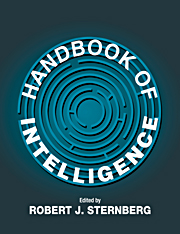Book contents
- Frontmatter
- Contents
- Preface
- Contributors
- PART I THE NATURE OF INTELLIGENCE AND ITS MEASUREMENT
- PART II DEVELOPMENT OF INTELLIGENCE
- PART III GROUP ANALYSES OF INTELLIGENCE
- PART IV BIOLOGY OF INTELLIGENCE
- PART V INTELLIGENCE AND INFORMATION PROCESSING
- 13 Simple information Processing and Intelligence
- 14 Complex Information Processing and Intelligence
- 15 Artificial Intelligence
- PART VI KINDS OF INTELLIGENCE
- PART VII TESTING AND TEACHING INTELLIGENCE
- PART VIII INTELLIGENCE, SOCIETY, AND CULTURE
- PART IX INTELLIGENCE IN RELATION TO ALLIED CONSTRUCTS
- Author Index
- Subject Index
15 - Artificial Intelligence
Published online by Cambridge University Press: 05 June 2012
- Frontmatter
- Contents
- Preface
- Contributors
- PART I THE NATURE OF INTELLIGENCE AND ITS MEASUREMENT
- PART II DEVELOPMENT OF INTELLIGENCE
- PART III GROUP ANALYSES OF INTELLIGENCE
- PART IV BIOLOGY OF INTELLIGENCE
- PART V INTELLIGENCE AND INFORMATION PROCESSING
- 13 Simple information Processing and Intelligence
- 14 Complex Information Processing and Intelligence
- 15 Artificial Intelligence
- PART VI KINDS OF INTELLIGENCE
- PART VII TESTING AND TEACHING INTELLIGENCE
- PART VIII INTELLIGENCE, SOCIETY, AND CULTURE
- PART IX INTELLIGENCE IN RELATION TO ALLIED CONSTRUCTS
- Author Index
- Subject Index
Summary
INTRODUCTION: WHAT ARTIFICIAL INTELLIGENCE IS NOT
What is artificial intelligence (AI)? You almost certainly have some ideas. Maybe you think that AI is the quest to build HAL. Maybe you think that AI is the quest to build Deep Blue. Maybe you think that AI is a grand waste of time, or impossible, or a bad idea.
These perspectives are indicative of a wide range of thinking about AI. The field of AI itself includes a similarly wide range of thinking about both what AI is and about how it should be achieved. A brief catalog of research areas that are typically included under the heading of AI includes the following:
Robotics
Natural Language Processing
Planning
Neural Nets
Computer Vision
Machine Learning
Computer Game Playing
Rule-based Systems
Case-based Reasoning, and many more.
Concisely defining a field that includes such diverse research areas is a nearly impossible task. Computer game playing, for example, shares little if anything with natural language processing, and yet these are both lumped under the title of AI. Any definition that would include both of those fields might well be so inclusive as to be meaningless.
On the surface, this chapter will be taking on not only that impossible task but two others as well: summarizing the history of AI and the current state of the field. Our hope is not to succeed comprehensively at any one of those tasks, although this chapter will certainly work in those directions.
- Type
- Chapter
- Information
- Handbook of Intelligence , pp. 341 - 356Publisher: Cambridge University PressPrint publication year: 2000
- 3
- Cited by



